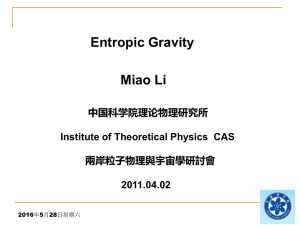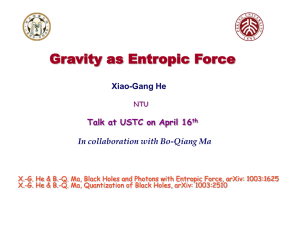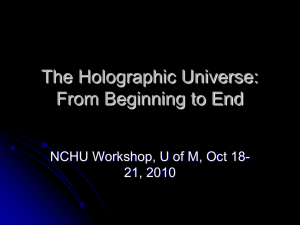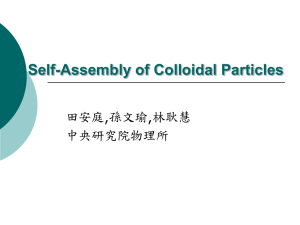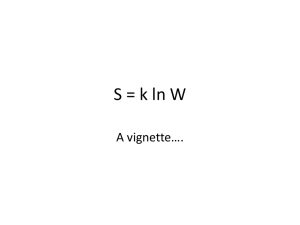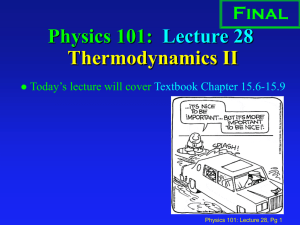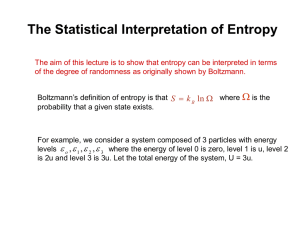r - kitpc
advertisement
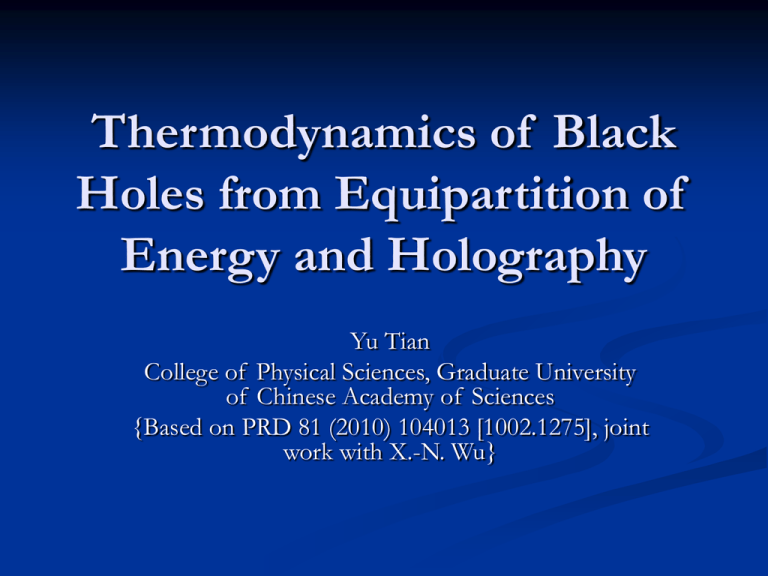
Thermodynamics of Black
Holes from Equipartition of
Energy and Holography
Yu Tian
College of Physical Sciences, Graduate University
of Chinese Academy of Sciences
{Based on PRD 81 (2010) 104013 [1002.1275], joint
work with X.-N. Wu}
Gravity as entropic force (E. Verlinde, On the Origin
of Gravity and the Laws of Newton, [1001.0785])
Key points:
One dimension of the space is emergent.
Holography.
“Equipartition of energy” on the holographic
screen.
Gravity is an entropic force.
Entropic force
Newton’s 2nd law from entropic force
Holography!
For horizon!
Change of entropy on the screen
Equipotential surface!
Entropic force
Temperature and acceleration
“Unruh effect”
Newton’s 2nd law
Newton’s gravity as entropic force
Special case – Newton’s law of gravity
c3 A
N
G
E
Microscopic D.O.F.?
1
Nk BT
2
E Mc 2 ,
“Equipartition rule”
A 4 R 2 , k BT
F ma G
1 a
2 c
Mm
R2
1 n 2 c3 A
N
2 n3 G
General case – the Poisson equation
a
No entropy here!
The change of entropy density due to arbitrary
displacement of a particle
Equipotential
surface or not?
dA
Remarks:
When (and, generically, only when) the
holographic screen is an equipotential surface,
the expression of the entropic force is
consistent with Newton’s law of gravity.
The (variation of) entropy density is
proportional to the (variation of) gravitational
potential, which suggests a coarse-graining
picture analogous to AdS/CFT.
Einstein’s gravity as entropic force
: Killing vector
N a a S 2
m
Fa T a S me a
1 n 2 c3
dN
dA
2 n3 G
Komar mass inside the screen!
Einstein equations?
Static
Stationary?
Questions:
1. How to test these arguments, especially the
consistency between the (possible) local and
global entropy variation postulations in the
relativistic case?
2. What is the relation (if any) between
Verlinde’s proposal and the traditional spacetime (black-hole) thermodynamics, especially
the entropy on the screen and the entropy of
horizon?
Non-relativistic case
The Laplace horizon:
2GM
rh
c2
GM
c4
2 h
r
4GM
The Verlinde temperature on the horizon:
GM
c3
T
Th
2
2 kBc 2 kBcr
8 kBGM
“Match” the Hawking temperature!
Higher dimensional case:
1/( n 3)
16 GM
rh
(n 2)n 2
(c 1)
(n 3)8 GM
n3
h
n2
(n 2)n 2 r
2rh
(n 3)
Th
4 k B rh
Still “match”!
Entropy formula
dA
c2
k B c3
h Sh
Ah
2
4G
“Match” the Bekenstein entropy!
New choice of the relativistic gravitational
potential
Verlinde’s potential is singular at the horizon
Our choice of the gravitational potential (YT &
X.-N. Wu, PRD 81 (2010) 104013 [1002.1275])
Have the same asymptotic behavior!
Verlinde’s proposal with our new potential
c2
k B c3
h Sh
Ah
2
4G
k BT
2 c
N a a
General spherical screen for Schwarzschild
t
GM
2 k B c
S
Mr
r
Recall the Bekenstein entropy bound
S
2 k B
Er
c
So our (relativistic) entropy just saturates the
Bekenstein bound.
Two simple models to check the formula of
variation of entropy
Thin shell model
R
Rm
= t
Charged dust shell model
R
Rm
q
Open questions:
How about the general case?
Entropic force for generic configurations
(even in the spherical case)?
Thermodynamic relations for our
(relativistic) entropy?
Alternative scheme
Note that in Verlinde’s original analysis and our
discussions above, the “position” of the screen is
fixed during the quasistatic processes, but in the
ordinary black-hole thermodynamics, it is the
Killing-horizon condition 12 of the
“screen” that is fixed during the quasistatic
processes.
So, a natural generalization of the ordinary blackhole thermodynamics is to consider the
quasistatic processes that keep fixed the
gravitational potential (or ) of the screen (Y.X. Chen & J.-L. Li, First law of thermodynamics
on holographic screens in entropic force frame,
[1006.1442]).
Take the ansatz
2
dr
ds 2 f (r )dt 2
r 2 d 2
f (r )
of spherically symmetric metrics.
Generalizing Smarr’s arguments, one obtains the
generalized first law of thermodynamics
dM TdS i dQi
i
associated to general spherical screen, with T the
Verlinde temperature and S equal to A4
everywhere (not only on the horizon) in the
framework of Einstein gravity.
Remarks:
Here M is the ADM mass of the spacetime, not the Komar mass inside the
screen. Equipartition rule.
Here the entropy S violates the Bekestein
bound (outside the horizon), but saturates
the holographic bound.
It is not clear how to realize Verlinde’s
assumption of entropy variation, and so
gravity as an entropic force, within this
scheme.
Generalizations
Dynamical case with spherical symmetry
R.-G. Cai, L.-M. Cao & N. Ohta, Notes on Entropy
Force in General Spherically Symmetric
Spacetimes, Phys. Rev. D 81 (2010) 084012.
Define the surface gravity and temperature
1
2
D a Da r , T
2
for a general spherical screen (r const.) in a
general spherically symmetric spacetime
By Einstein equations, there exists a generalized
equipartition rule
E
1
n 1
Nk BT
wV
2
n3
where E is the Misner-Sharp (or Hawking-Israel)
energy inside the screen, w the work density
1
w Taa
2
and V the “volume”
V
n 2 n 1
r
n 1
Remarks:
The generalized equipartition rule holds
instantaneously for a general spherical screen.
The Misner-Sharp (or Hawking-Israel) energy is
different from the Komar energy even in general
static case.
The temperature T here is different from the
Verlinde temperature even in general static case.
Upon redefinition of the temperature T as the
“effective” one, the generalized equipartition rule
superficially becomes the “standard” one.
Stationary case (YT & X.-N. Wu, PRD 81 (2010)
104013 [1002.1275])
The choice of Killing vector
Concluding remarks & open questions
1. From the holographic point of view, the gravity can
be regarded as an entropic force, and the Einstein
equations can be (at least partially) given by the
equipartition of energy on the holographic screen.
2. Various definitions of temperature and quasilocal
mass/energy arise in this framework (or its
generalizations).
3. How to reconcile the two (or more) types of entropy
arising in this framework?
4. Generalization to theories other than Einstein’s?
5. …
Thank you!
